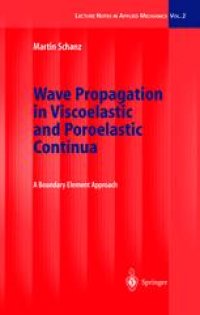
Ebook: Wave Propagation in Viscoelastic and Poroelastic Continua: A Boundary Element Approach
Author: Dr.-Ing. Martin Schanz (auth.)
- Tags: Continuum Mechanics and Mechanics of Materials, Numerical Analysis, Mechanics
- Series: Lecture Notes in Applied Mechanics 2
- Year: 2001
- Publisher: Springer-Verlag Berlin Heidelberg
- Edition: 1
- Language: English
- pdf
In this book, a numerical method to treat wave propagation problems in poroelastic and viscoelastic media is developed and evaluated. The method of choice is the Boundary Element Method (BEM) since this method implicitly fulfills the Sommerfeld radiation condition. The crucial point in any time-dependent BEM formulation finding time-dependent fundamental solutions is overcome employing the Convolution Quadrature Method. This quadrature rule makes it possible to establish a boundary element time-stepping procedure based on the known Laplace domain fundamental solutions for viscoelastic and poroelastic continua. Using this method, e.g., tremors produced by earthquakes or machines can be pre-calculated and subsequent buildings prevented from such disturbances.
In this book, a numerical method to treat wave propagation problems in poroelastic and viscoelastic media is developed and evaluated. The method of choice is the Boundary Element Method (BEM) since this method implicitly fulfills the Sommerfeld radiation condition. The crucial point in any time-dependent BEM formulation finding time-dependent fundamental solutions is overcome employing the Convolution Quadrature Method. This quadrature rule makes it possible to establish a boundary element time-stepping procedure based on the known Laplace domain fundamental solutions for viscoelastic and poroelastic continua. Using this method, e.g., tremors produced by earthquakes or machines can be pre-calculated and subsequent buildings prevented from such disturbances.
In this book, a numerical method to treat wave propagation problems in poroelastic and viscoelastic media is developed and evaluated. The method of choice is the Boundary Element Method (BEM) since this method implicitly fulfills the Sommerfeld radiation condition. The crucial point in any time-dependent BEM formulation finding time-dependent fundamental solutions is overcome employing the Convolution Quadrature Method. This quadrature rule makes it possible to establish a boundary element time-stepping procedure based on the known Laplace domain fundamental solutions for viscoelastic and poroelastic continua. Using this method, e.g., tremors produced by earthquakes or machines can be pre-calculated and subsequent buildings prevented from such disturbances.
Content:
Front Matter....Pages I-X
Introduction....Pages 1-6
Convolution quadrature method....Pages 7-21
Viscoelastically supported Euler-Bernoulli beam....Pages 23-38
Time domain boundary element formulation....Pages 39-56
Viscoelastodynamic boundary element formulation....Pages 57-76
Poroelastodynamic boundary element formulation....Pages 77-103
Wave propagation....Pages 105-134
Conclusions — Applications....Pages 135-141
Back Matter....Pages 143-170
In this book, a numerical method to treat wave propagation problems in poroelastic and viscoelastic media is developed and evaluated. The method of choice is the Boundary Element Method (BEM) since this method implicitly fulfills the Sommerfeld radiation condition. The crucial point in any time-dependent BEM formulation finding time-dependent fundamental solutions is overcome employing the Convolution Quadrature Method. This quadrature rule makes it possible to establish a boundary element time-stepping procedure based on the known Laplace domain fundamental solutions for viscoelastic and poroelastic continua. Using this method, e.g., tremors produced by earthquakes or machines can be pre-calculated and subsequent buildings prevented from such disturbances.
Content:
Front Matter....Pages I-X
Introduction....Pages 1-6
Convolution quadrature method....Pages 7-21
Viscoelastically supported Euler-Bernoulli beam....Pages 23-38
Time domain boundary element formulation....Pages 39-56
Viscoelastodynamic boundary element formulation....Pages 57-76
Poroelastodynamic boundary element formulation....Pages 77-103
Wave propagation....Pages 105-134
Conclusions — Applications....Pages 135-141
Back Matter....Pages 143-170
....